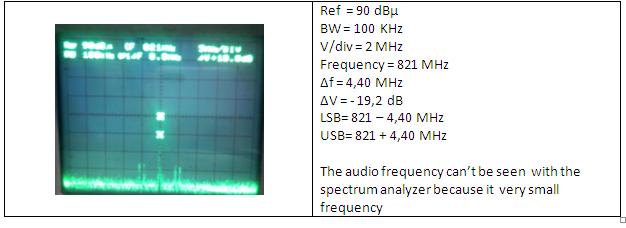Objectives :
Instruments:
Circuit Diagram
Theory
Video modulator is a circuit which converts composite video signaland audio to an RF signal which can be connected to TV antenna input. In video modulators audio+video is modulated onto a radio frequency (VHF or UHF) carrier in the range of 30 MHz to 900 MHz. This means that using a video modulator you can fed the normal video signal you get from video out connector (RCA or BNC) to a signal which can be connected to antenna input connector (F-connector orIEC antenna connector) of another video device. Basically a video modulator is a very low power TV transmitter. Most analogue TV systems use a modulation called vestigial sideband.Vestigial sideband is an AM signal with most of one sideband filtered out to save bandwidth (all you need is the carrier and one sideband torecover the video). This is how broadcasters do this. In simple devicesit is usually easier to leave a "Vestige" of the other sideband to prevent phase shift from the filter affecting the signal quality.
The way to emit (transmit) signal of pictures that amplitude modulated similar with a radio broadcasting system that has been known. In both cases, the amplitude of a carrier wave radio frequency (RF) is made varies with the modulating voltage. Modulation is a signal of fundamental frequency (baseband). On television, this baseband signal is a composite video signal. Broadcast television is really such a radio system, but includes pictures and sound. Sound signal emitted by joining in it frequency modulation (FM) on a separate carrier wave transmitter in the same channel as the image signal.
Understanding the image signal is used here to mean a modulated carrier wave. The video signal is a signal to a picture tube. Video signal to television audio signal corresponds to the sound system. Details are clearer than the image signal AM (amplitude modulation picture) and an FM voice signal.
Figure 1. wave amplitude modulated composite video signal
Figure 2. Image signal AM frequency spectrum a). Without VSB. b). With VSB
Figure 2.a shows the frequency spectrum of video transmission that produces an image signal comprising AM picture carrier frequency (center frequency) and sound carrier frequencies (frequency side of the upper and lower side frequencies) - without VSB, while Figure 2b shows the frequency spectrum in transmission generate video image signals of AM frequencies only have the upper side only (with VSB).
Step :
3. Turn ON the instruments
4. Determine the output of video modulator (RF) with spectrum analyzer and see the frequency spectrum.
5. Draw the spectrum.
6. Determine how much the picture carrier frequency, audio carrier frequency and difference of carrier frequency of picture and audio.
7. See the spectrum, determine the kindof modulation that be used in that transmission with change the FREQ, SPAN (in the smallest scale)
8. Draw the multiply frequency spectrum and frequency base.
Question
1. What system that be used in that video modulator ?
2. From the sixth step, how to know thekind of modulation ?
Result
Answer
1. Modulation system that be used in that video is Amplitude modulation, because the amplitude of information signal give effect to the amplitude of carrier signal, information signal becoming a cover of carrier signal
The general using of Am signal is : to Broadcasting Am radio that many used to broadcast the radiosignal AM, TV picture (Video), Communication radio : aeroplane, amateur radio (SSB), CB radio ( Citizen Band Radio). Digital taransmissiondata : Computer Modem (Combination with QAM modulation).
2. We know that the kind of modulation is amplitude modulation can be seen from the difference of amplitude and had the AM spectrum.
From the AM formula, we know that the modulated signal spectrum AM had 3 frequencies :
· Fc : carrier signal frequency
· LSB : Lower Side Band Frequency, that is difference of carrier signal frequency and information signal.
· USB : Upper Side Band Frequency, that is summary of carrier signal frequency and information signal.
Conclusion
2. AM Modulation in spectrum analyzer show three frequencies :
· Carrier frequency (fc)
· Lower Side band Frequency (LSB)
· Upper Side BandFrequency (USB)
3. The difference between USB and LSB for about 4,40 MHz
4. Bandwidth that be used is 100 KHz
















